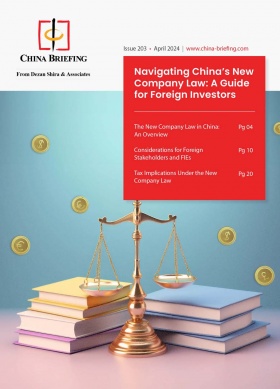China-Germany Bilateral Relations: Trade and Investment
The evolving trade and investment landscape between China and Germany reflects both enduring cooperation and emerging challenges as intensified industrial competition reshapes key sectors.
China and Germany have long maintained a mutually beneficial trade relationship, with each country holding importance as a trading partner for the other. For nearly five decades, Germany has consistently ranked as China’s top trading partner in Europe, while China has maintained its position as Germany’s primary trading partner for eight consecutive years.
However, this longstanding period of symbiotic economic relations between the two countries is now undergoing a transformation. There is a discernible shift towards intensified industrial competition, particularly in sectors where German manufacturing companies have traditionally held dominance, such as the automotive industry. Moreover, this shift could have significant implications for Europe’s stance on China, given Germany’s central role in the EU-China relationship.
In this article, we discuss the latest data on bilateral trade and investment between China and Germany. Additionally, we provide an overview of the various tax and investment treaties signed by the two countries, offering insights into the legal framework that underpins their economic relationship.
China-Germany diplomatic relations
Diplomatic ties between the Federal Republic of Germany and the People’s Republic of China were established in 1972. Since then, the relationship between China and Germany has evolved into a complex and dynamic one. Both Germany and the European Union perceive China simultaneously as a partner, a competitor, and – more recently – a systemic rival.
In March 2014, under the leadership of Chinese President Xi Jinping and former German Chancellor Angela Merkel, China and Germany elevated their relationship to a comprehensive strategic partnership. Under former Chancellor Merkel’s leadership, both diplomatic and economic relations between China and Germany flourished. In 2016, China emerged as Germany’s largest single trading partner, overtaking the United States.
Amidst international crises and escalating global challenges such as climate change and the recent COVID-19 pandemic, there is a growing emphasis on the necessity of cooperation and coordination between Germany and China. Germany advocates for meaningful and mutually beneficial relations between the EU and China, as well as enhanced unity within the EU concerning China-related matters. From China’s perspective, Germany is regarded as a crucial partner – both economically and politically within Europe.
Recent developments
In July 2023, Germany released its first-ever China Strategy. The document indicates a strategic shift towards diminishing economic dependence on China while ensuring stability in the supply chain. The move, amid concerns regarding subsidies for electric vehicles and telecom equipment, has been a nuanced approach to collaboration with China. The emphasis on de-risking rather than decoupling signifies a readiness to engage with China despite existing disparities.
In October 2023, the governments of China and Germany issued a significant 25-point Joint Statement aimed at broadening market access and enhancing cooperation in capital market investments. This agreement was reached in Frankfurt, following the first high-level financial dialogue between the two countries in four years, and effectively superseding the 2019 version. It underscores a renewed commitment to addressing potential barriers to cross-border transactions and collaborating with fellow G20 members on debt relief initiatives for low- and middle-income nations.
Furthermore, the meeting between President Xi and German Chancellor Olaf Scholz in Beijing on April 16, 2024, reaffirmed the enduring strength of the bilateral relationship between China and Germany. President Xi stressed the significance of viewing and developing bilateral relations from a long-term and strategic perspective, emphasizing stability and certainty as essential elements in shaping global dynamics. Chancellor Scholz echoed these sentiments, expressing Germany’s dedication to enhancing bilateral ties and fostering dialogue and cooperation across various sectors, including education and culture.
Both leaders noted the importance of commemorating the 10th anniversary of the all-round strategic partnership between China and Germany, highlighting the consistent growth and deepening cooperation witnessed over the past decade. They emphasized the mutual benefits derived from pragmatic cooperation and stressed the importance of maintaining an objective and dialectical view on issues such as production capacity and economic cooperation.
Additionally, they reached a consensus on various global challenges, including the Ukraine crisis and the Israeli-Gaza conflict, reaffirming their commitment to contributing to world peace, stability, and growth through enhanced bilateral cooperation and multilateral engagement.
Bilateral trade and investment
China remained Germany’s primary trading partner for goods in 2023, with a trade volume exceeding EUR 250 billion (approx. US$266.68 billion), though this marked a 15.5 percent decrease from the previous year.
According to the Federal Statistical Office (Destatis), in terms of foreign trade volume, the margin between Germany’s trade with China and the United States narrowed in 2023, with China surpassing the US by just EUR 0.7 billion (approx. US$0.74 billion), compared to a difference of EUR 50.1 billion (approx. US$62 billion) in 2022.
At the same time, Germany saw a significant reduction in its trade deficit with China in 2023, marking the first decrease since 2018 and contributing to a substantial increase in its overall surplus, as reported by Bloomberg. Data released by Destatis revealed that the trade gap with China narrowed to EUR 58.4 billion (approx. US$62.3 billion), down from EUR 86 billion (approx. US$91.7 billion) in 2022. This improvement was primarily driven by a more than 19 percent decline in Chinese imports, while exports decreased at a slower rate.
Despite this development, the trade unbalance between Germany and China remains a concern for Europe’s largest economy. To address this issue, the German government recently established a state fund with EUR 1 billion (approx. US$1.06 billion) aimed at investing in mining projects outside China. The goal is to reduce China reliance for critical raw materials necessary for future technologies like batteries, semiconductors, and green energy.
Notably, while German exports to China represent only about 8 percent of the country’s total foreign sales, the economic relationship extends far beyond these figures. Major German companies like Daimler, Volkswagen, and BMW have established significant production facilities in China, contributing substantially to their profits. Moreover, firms such as Siemens and BASF have made substantial investments in China, strengthening economic ties between the two countries.
In 2023, Germany’s primary exports to China, based on value-added categories, included vehicles, machinery, nuclear reactors and boilers, electrical and electronic equipment, optical, photo, and medical apparatus, as well as pharmaceutical products, according to data from ICT Trade Map.
| Main Chinese Imports from Germany, 2023 | |
| Product category | Value (US$) Billion |
| Vehicles other than railway, tramway | 23.22 |
| Machinery, nuclear reactors, boilers | 22.79 |
| Optical, photo, technical, medical apparatus | 13.57 |
| Pharmaceutical products | 11.62 |
| Miscellaneous chemical products | 7.91 |
| Source: ICT Trade Map | |
Meanwhile, in the same year, the main goods exported from China to Germany were electrical and electronic equipment, machinery, nuclear reactors and boilers, vehicles, and furniture and apparel.
| Main Chinese Exports to Germany, 2023 | |
| Product category | Value (US$) Billion |
| Electrical, electronic equipment | 33.72 |
| Machinery, nuclear reactors, boilers | 18.97 |
| Vehicles other than railway, tramway | 5.65 |
| Furniture, lighting signs, prefabricated buildings | 4.31 |
| Optical, photo, technical, medical apparatus | 4.08 |
| Source: ICT Trade Map | |
Foreign direct investment
Over the past 10 years, there have been significant shifts in direct investment between China and Germany. The investment landscape has become more complex: while German investments in China are still increasing, these investments have primarily been funded through reinvested profits since 2019. And the proportion of German firms opting to withdraw capital from China is increasing.
Despite this, certain sectors like automotive and advanced manufacturing, which offer substantial growth opportunities, continue to attract German businesses to China. Moreover, the significant reinvestment of earnings indicates that established companies are strengthening their commitments to the Chinese market. Similarly, in Germany, the promising prospects for electric vehicle sales are driving interest among Chinese firms, albeit against an otherwise subdued investment backdrop.
German investment in China
As reported by Reuters, in 2023, German companies invested nearly EUR 12 billion (approx. US$13 billion) in direct investments in China, marking a 4.3 percent increase from the previous year. This demonstrates a solid desire to broaden operations in the world’s second-largest economy. Despite heightened scrutiny from the European Union regarding security apprehensions linked to such investments, German firms exhibited a strong willingness to expand their presence in China.
An analysis from the IW institute, utilizing official Bundesbank data, revealed that in 2023, investment in China as a proportion of Germany’s total investments abroad surged to 10.3 percent, marking its highest level since 2014. Concurrently, the report highlighted that German FDI in other Asian countries remained relatively unchanged, hovering around 8 percent.
Meanwhile, China’s Ministry of Commerce (MOFCOM) reported a 21 percent year-on-year increase in the actual utilization of foreign capital from Germany to China during the first eight months of 2023.
However, the landscape of German investment in China reveals a more nuanced scenario. Over the past four years, German investments in China have primarily been funded through reinvested profits, with some companies opting to withdraw capital. This trend highlights a divergence between larger corporations and the majority of small and medium-sized enterprises (SMEs).
According to a recent survey conducted by the German Chamber of Commerce in China, the proportion of German firms contemplating or executing an exit strategy from the Chinese market has more than doubled to 9 percent over the same period.
Chinese investment in Germany
Chinese investment in Germany experienced a significant decline during the first three quarters of 2023. Data from the Deutsche Bundesbank indicates that EUR 2.3 billion (approx. US$2.4 billion) of direct Chinese investment exited the market, marking a drastic 233 percent decrease compared to the positive flow of EUR 3.7 billion (approx. US$3.9 billion) recorded in 2022.
Similarly, FDI flows from China to Europe have been diminishing in recent years. In 2022, a joint report from MERICS and Rhodium Group revealed that Chinese FDI in Europe fell to just EUR 7.9 billion (approx. US$8.4 billion), representing a 22 percent decrease compared to 2021. This level of investment mirrors the figures seen in 2013, indicating a notable downturn in Chinese FDI in Europe.
Trade and investment treaties
China-Germany bilateral investment agreement
In 1983, China and Germany signed a bilateral investment agreement (BIT), which was later updated in 2003 and took effect in 2005, superseding the earlier version.
The China-Germany BIT fosters an investment-friendly environment, prioritizing legal certainty and investor protection from both nations while promoting collaborative economic endeavors. It incorporates several pivotal provisions:
- Investment protection: The agreement safeguards investments against actions such as expropriation, nationalization, and discriminatory treatment, ensuring the security of investor interests.
- Dispute resolution mechanisms: The BIT establishes avenues for resolving conflicts through negotiation, mediation, or arbitration, including an investor-state dispute settlement (ISDS) clause outlined in Article 9.
In addition, the BIT also incentivizes investment flows by offering guarantees, support, and incentives to investors, fostering a conducive environment for mutual economic growth. It upholds principles of non-discrimination, ensuring that investors from either country receive fair and equitable treatment compared to others.
Emphasis is also placed on transparency and adherence to the rule of law, ensuring clear and consistent investment regulations and providing access to legal remedies when necessary.
China-Germany double taxation avoidance agreement
In addition to the BIT, China and Germany have also signed a double taxation agreement (DTA), which prevents companies and individuals from being taxed on the same income in both countries. The China-Germany DTA, effective as of January 1, 2017, supersedes the previous income and capital tax treaty signed in 1985 between the two nations.
The DTA pertains to income taxes imposed by both China and Germany, covering:
- Chinese individual income tax (IIT) and corporate income tax (CIT); and
- German income tax, corporation tax, trade tax, and capital tax.
The DTA also outlines the definition of “permanent establishment” with respect to tax liability in one of the contracting countries. According to the DTA, a permanent establishment arises when a business provides services within a contracting state through employees or engaged personnel for the same or related project, exceeding a cumulative period of 183 days within any 12-month period.
Withholding tax rates are outlined as follows:
- Dividends: Rates differ depending on ownership and income source, ranging between 5 percent and 15 percent, with a standard rate of 10 percent for other scenarios.
- Interest: Typically set at 10 percent, except for specific cases such as sales on credit of commercial or scientific equipment, which may be exempt.
- Royalties: Rates vary from 6 percent to 10 percent, contingent on the type of royalties paid.
The DTA also outlines circumstances under which capital gains derived by a resident of one contracting state may be taxed by the other, including:
- Gains from the alienation of immovable property;
- Movable property forming part of a permanent establishment; and
- Shares deriving substantial value from immovable property in the other state.
In the context of double taxation relief, China follows the credit method, which means that if income is taxed in both China and another country, the taxpayer can typically claim credit in China for the taxes paid abroad, thus reducing the overall tax burden.
On the other hand, Germany generally applies the exemption method, where income earned abroad may be exempt from taxation in Germany, provided certain conditions are met. However, there are instances where Germany may opt to use the credit method for particular types of income, following the German tax legislation.
Notably, Article 29 of the China-Germany DTA introduces a limitation on benefits (LOB) provision, stipulating that treaty benefits won’t apply if the primary purpose of certain transactions or arrangements is to obtain these benefits in a manner contrary to the treaty’s objectives and provisions.
Multilateral treaties
China and Germany, both members of the WTO, are signatories to various multilateral treaties concerning trade and investment. These include:
- The Agreement on Trade-Related Aspects of Intellectual Property Rights (TRIPS), which mandates WTO members to extend intellectual property rights to owners in any member state. It incorporates a most-favored-nation (MFN) clause, ensuring equal treatment for IP rights protection across all member countries. Additionally, it provides mechanisms for dispute resolution and compensation.
- The Agreement on Trade-Related Investment Measures (TRIMs), which prohibits the implementation of investment measures that restrict trade between members. This includes measures like local content requirements, which mandate the use of locally-produced goods or services by companies operating in a market.
- The General Agreement on Trade in Services (GATS), which grants most-favored-nation status to service providers of any WTO member, excluding governmental services such as social security, public health, education, and certain services related to air transport.
About Us
China Briefing is one of five regional Asia Briefing publications. It is supported by Dezan Shira & Associates, a pan-Asia, multi-disciplinary professional services firm that assists foreign investors throughout Asia, including through offices in Beijing, Tianjin, Dalian, Qingdao, Shanghai, Hangzhou, Ningbo, Suzhou, Guangzhou, Haikou, Zhongshan, Shenzhen, and Hong Kong in China. Dezan Shira & Associates also maintains offices or has alliance partners assisting foreign investors in Vietnam, Indonesia, Singapore, India, Malaysia, Mongolia, Dubai (UAE), Japan, South Korea, Nepal, The Philippines, Sri Lanka, Thailand, Italy, Germany, Bangladesh, Australia, United States, and United Kingdom and Ireland.
For a complimentary subscription to China Briefing’s content products, please click here. For support with establishing a business in China or for assistance in analyzing and entering markets, please contact the firm at china@dezshira.com or visit our website at www.dezshira.com.
- Previous Article How to Get a Certificate of No Criminal Record in China – A Guide for Foreign Residents
- Next Article La Cina rilascia 24 nuove misure per attrarre gli investimenti esteri








